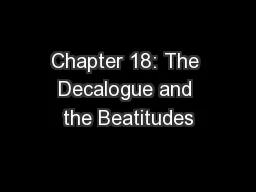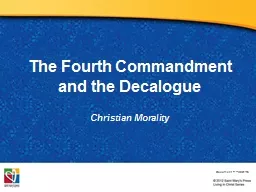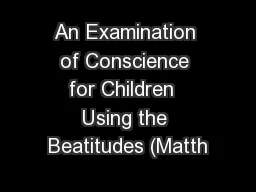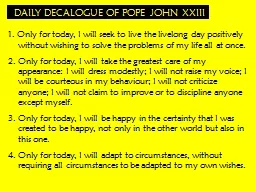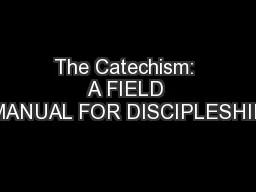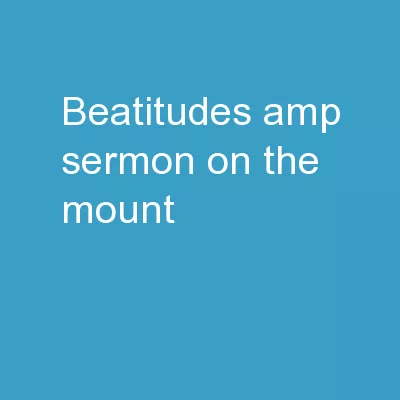PPT-Chapter 18: The Decalogue and the Beatitudes
Author : lois-ondreau | Published Date : 2019-02-15
INTRODUCTION TO CATHOLICISM ANTICIPATORY SET Demonstrate the continuity and progress of law from the Old Testament to the New 1 The Ten Commandments and Christ
Presentation Embed Code
Download Presentation
Download Presentation The PPT/PDF document "Chapter 18: The Decalogue and the Beatit..." is the property of its rightful owner. Permission is granted to download and print the materials on this website for personal, non-commercial use only, and to display it on your personal computer provided you do not modify the materials and that you retain all copyright notices contained in the materials. By downloading content from our website, you accept the terms of this agreement.
Chapter 18: The Decalogue and the Beatitudes: Transcript
INTRODUCTION TO CATHOLICISM ANTICIPATORY SET Demonstrate the continuity and progress of law from the Old Testament to the New 1 The Ten Commandments and Christ pp 406409 BASIC QUESTION . And 57375en 57375ere Were None meets the standard for Range of Reading and Level of Text Complexity for grade 8 Its structure pacing and universal appeal make it an appropriate reading choice for reluctant readers 57375e book also o57373ers students Christian . Morality. Document #: TX001173. Shutterstock. /CREATISTA. Shutterstock. /Monkey Business Images. Shutterstock. /. Goodluz. shutterstock-sonya. . etchison. wpwittman.com. “Children, obey your parents [in the Lord], for this is right. ‘Honor your father and mother.’ This is the first commandment with a promise, ‘that it may go well with you and that you may have a long life on earth’” . A . Summary . (Dcn D. McManaman). The Beatitudes. Each beatitude begins with . Makarios. ("Blessed are..."), which is . a . blessedness . or happiness that . is sufficient unto itself, complete, and . 2 Blessed are the peacemakers for they shall be called sons and daughters of God. Do I value everyone as a child of God? Do I try to get along with everyone, especially family, neighbors and cla 2. Only for today, I will take the greatest care of my appearance: I will dress modestly; I will not raise my voice; I will be courteous in my behaviour; I will not criticize anyone; I will not claim to improve or to discipline anyone except myself.. Sermon on the Mount. Matthew 5: 1 - 12. Blessed are the poor in spirit, for theirs is the kingdom of heaven. Poor in spirit means:. Knowing that we need God in all things. Knowing that God is above all and that we are sinners. Reformation Lectures. Concordia Theological Seminary. Fort Wayne, Indiana. Discipleship: Two Approaches. American Evangelicalism: Fixing the Church. Mainline Protestants: Fixing the World. The Lutheran Take on Discipleship. When you think of grandfathers, what comes to mind?. What are the seven grandfather teachings?. They are cherished virtues within many Aboriginal communities.. . Virtues. = good habits. A long time ago, 7 Grandfathers were concerned with the attitudes and behaviours of humanity.. Thus. , God challenges us to take the metaphorical road less travelled despite all difficulty. By following these Beatitudes, we create a life rooted in God’s love. . The . actual word “beatitude” comes from the Greek work for “blessed” or “promise of true happiness”. . Blessed Are YOU!!. Session #1. September 20. th. , 2016. Agenda… . Introductions (Fr. Dave). A Mini Lecture on the background of the Beatitudes (Pr. Bob). Exploring the Scriptures (Fr. Dave). Closing Devotion (Pr. Bob. The mystery of the redemption . begins. with the . Incarnation. JuaJuan. . The Parable of Juan and the Fishbowl. Why God became flesh?. 1. To save us from our sins and reconcile us to God. “For God so loved the world that He gave His only Son, so that whoever believes in Him might not perish but might have eternal life”- Jn. 3:16. Passages To Ponder. Passages To Ponder. INTRODUCTION. 1. All Scripture is given by inspiration of God.... a. Profitable for doctrine, reproof, correction, instruction in righteousness - . 2 Ti 3:16. b. Enabling the man of God to be complete, thoroughly equipped for every good work - . Passages To Ponder. Passages To Ponder. INTRODUCTION. 1. All Scripture is given by inspiration of God.... a. Profitable for doctrine, reproof, correction, instruction in righteousness - . 2 Ti 3:16. b. Enabling the man of God to be complete, thoroughly equipped for every good work - . 2017 Summer First Light. Slides on Line. Go To:. . mcleanbible.org/connect/. first-light-second light. CLICK ON:. FIRSTLIGHT AUDIO ARCHIVES 2016-2017 AND BEYOND. File Name:. 2017 Summer First Light.
Download Document
Here is the link to download the presentation.
"Chapter 18: The Decalogue and the Beatitudes"The content belongs to its owner. You may download and print it for personal use, without modification, and keep all copyright notices. By downloading, you agree to these terms.
Related Documents

